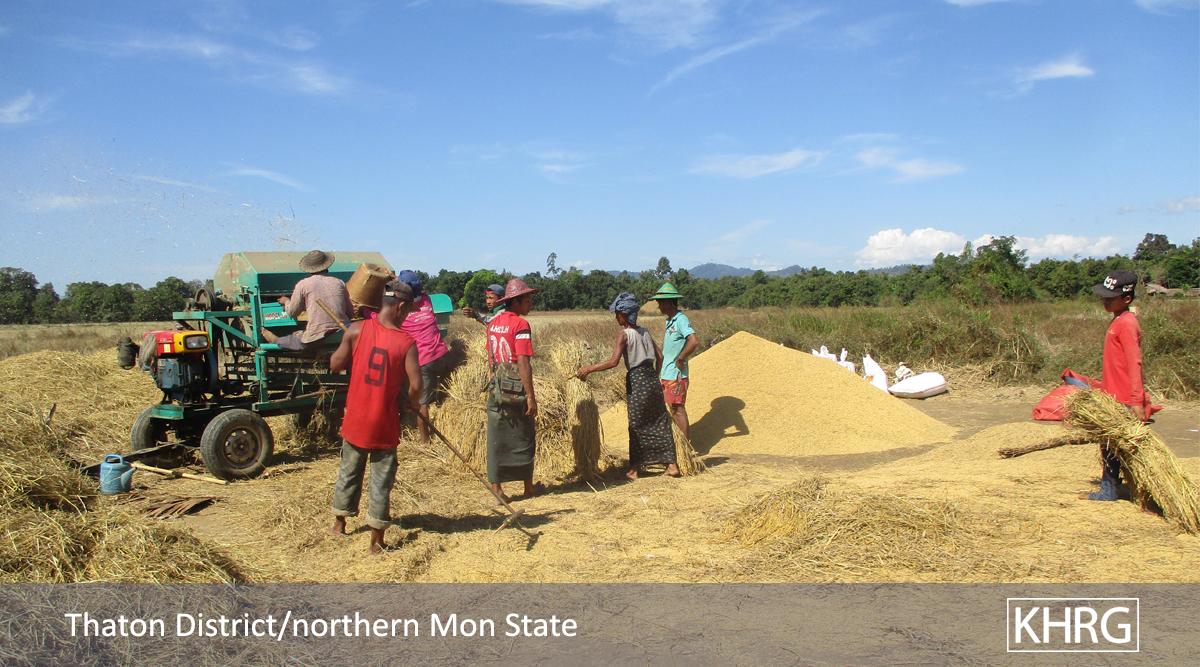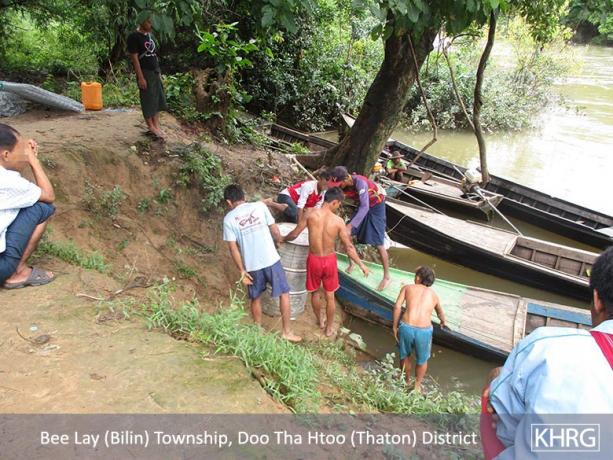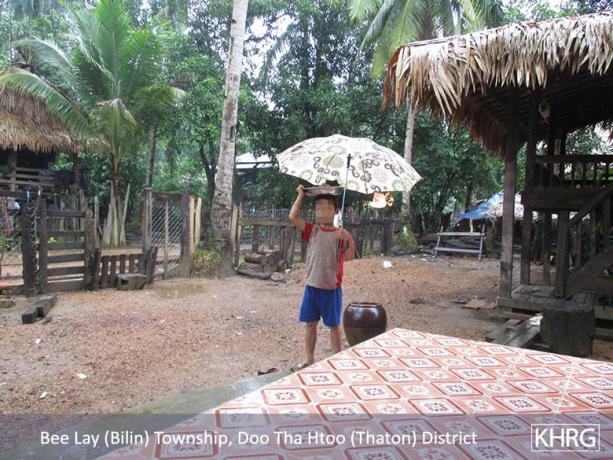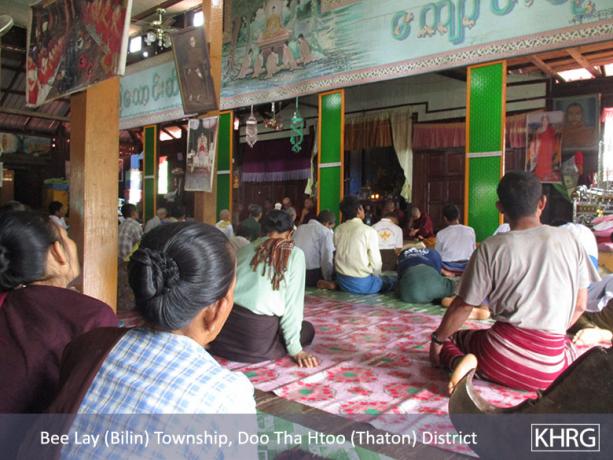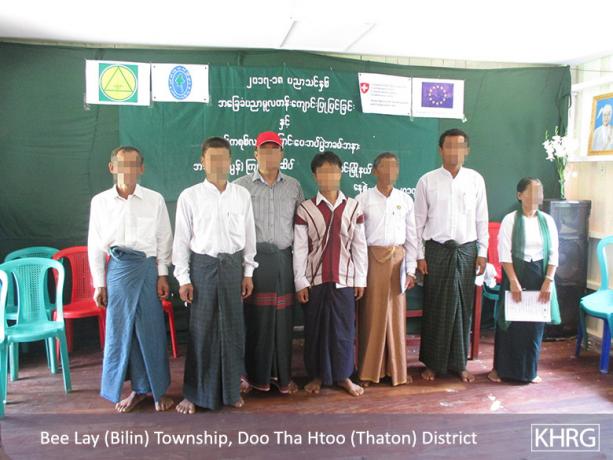This Situation Update describes events occurring in Bilin Township, Thaton District during the period between July and October 2017, including education, healthcare, villagers’ livelihoods, military activities, development projects and drug issues.
- Self-funded schools from Bilin Township, Thaton District do not have a sufficient amount of available teachers and face challenges transferring students to higher Standards in Burma/Myanmar government schools.
- Since the Nationwide Ceasefire agreement was signed in 2015, many Non-Government Organisations (NGOs), Burma/Myanmar government organisations and Community Based Organisations (CBOs) have provided awareness training workshops and have been constructing schools and clinics for community development.
- Access to healthcare remains limited due to the insufficient availability of medical supplies and health workers in areas such as Htee Hpa Doh Hta village tract and thus villagers have requested the Karen National Union (KNU) and the Burma/Myanmar government to increase the number of health workers.
- Villagers reported an increasing availability of illegal drugs in Bilin Township; the KNU has arrested 11 yaba users and sellers in June 2017.
Situation Update | Bilin Township, Thaton District (July to October 2017)
The following Situation Update was received by KHRG in November 2017. It was written by a community member in Thaton District who has been trained by KHRG to monitor human rights conditions. It is presented below translated exactly as originally written, save for minor edits for clarity and security.[1] This report was received along with other information from Thaton District, including 6 interviews and 53 photographs.[2]
Introduction
This situation update describes events occurring in Bilin Township, Thaton District during the period between July 1st and October 1st 2017, including education, healthcare, villagers’ livelihoods, military activities, development projects and drug issues.
Bilin Township location
Bilin Township, Thaton District is located close to Dwe Lo Township, Mu Traw [Hpapun] District and the Bu Lo [Bilin] river is the border between the two townships. According to the Burma/Myanmar government administration, part of Bilin Township is in Mon State and another part is in Karen State. There are 17 village tracts[3] under Karen National Union [KNU] control: Shwe Aok, Kaw Heh, T’gay Laung, Pyin Ma Pin, Noh Ber Baw, Htee Maw Khee, Ka Au Khi, Yo K’la, Kyo Waing, Lay Kay, Ta Paw, Me N’than, Ai Kyu Khee, Meh Play Khee, Shwe Laung Aye, Pi Ti Khi and Mel Naw Gaw Hta village tracts. Bilin Township is located along the Don T’mi Chaung River and the Bilin River.
Education
There are several types of school systems operating in Bilin Township: self-funded schools, joint Burma/Myanmar government and self-funded schools, Burma/Myanmar government schools, Karen Education Department [KED] schools and religious [Christian] schools. Self-funded schools rely on villagers’ support, as villagers provide the salary that secures teachers’ livelihoods and access to rice.
Self-funded schools annually face teacher shortages and challenges related to securing transfer letters. After the students at self-funded schools complete Standard Four,[4] they are required to secure transfer letters in which the Burma/Myanmar government recognises that the students can transfer to the next Standard [Standard Five] in the Burma/Myanmar government schools. Karen village leaders and the school committees of self-funded schools have attempted to resolve this challenge by registering their Standard Four students’ names at Burma/Myanmar government schools in 2016-2017. However, although some self-funded schools have successfully solved this problem using this strategy, other self-funded schools still face challenges [transferring students]. In the 2017-2018 academic year, three students who completed Standard Four at Htaw Klaw Khee self-funded school, Noh Ber Baw village tract [in early 2017] were prohibited from transferring to Standard Five in Baw Kyo Leh [a Burma/Myanmar government school], Dwe Lo Township, Mu Traw District by the principal Sayama Daw Thanda Aung. Thus, two of the students returned to Kya Thaung Seik [Yo Kla village] Burma/Myanmar government school and were able to transfer to Standard Five there because the Kya Thaung Seik school is more flexible with [transferring students from] self-funded schools. The other student is repeating Standard Four as a student at the Baw Kyo Leh government school.
A [censored for security] self-funded school principal reported, “One of my students finished Standard Four at the [censored for security] self-funded school but was prohibited from transferring to Standard Five by the principal of K’Ma Maung Burma/Myanmar government schools, Daw Htay Myint Yee, so the student has to attend Kya Thaung Seik school [Burma/Myanmar government school].” Self-funded schools [in Bilin Township] use the Burma/Myanmar government teaching curriculum and self-funded schools that cooperate with Burma/Myanmar government schools have both Burma/Myanmar government teachers and village teachers. Consequently, villagers have to provide food for both Burma/Myanmar government teachers and villager teachers.
Self-funded schools that cooperate with the Burma/Myanmar government schools are only permitted to teach Karen language up to Standard Two. However, some self-funded schools teach Karen language up to Standard Four in extra classes [after or before school hours]. One teacher reported that,
“Some self-funded schools that cooperated with the Burma/Myanmar government schools cannot teach Karen language during school hours because the Burma/Myanmar government Education Department prohibits the Karen subject from being taught.”
Furthermore, one villager reported that,
“The Burma/Myanmar government teachers arrive late to class and also do not fulfil their [teaching] responsibilities because they are [frequently] absent from the school.”
There are only two Karen Education Department [KED] schools [in Bilin Township]: Kwee Lay high school in Noh Ber Baw village tract and Htee Lay Hkaw post-ten school[5] in Lay Kay village tract. The Kwee Lay high school was established in 2010 and the Htee Lay Hkaw post-ten school was established in 2014.
Health Care
The most prevalent sicknesses affecting villagers in Bilin Township are [high/low] blood pressure, anaemia, cough, malaria and flu. The Burma/Myanmar government constructed clinics in other areas such as Htee Hpa Doh Hta but these clinics are always closed because they lack medical supplies and health workers. There are KNU clinics, but some villages cannot access nearby clinics. Thus, villages that face serious illnesses have to travel to hospitals in towns such as K’Ma Maung, Thaton and Hpa-an. Villagers also face transportation problems because the quality of the roads from their villages to the towns are not good. Villagers request the Karen National Union or the Burma/Myanmar government to provide clinics and health workers for them.
Villagers’ livelihoods
Villagers from Bilin Township continue to do ordinary work such as hill farming, plain farming, daily labour and plantations because there are no major business opportunities. Farmers annually face inadequate rice [harvests]. One villager reported, “When we face food shortages, we have to work as daily labourers, collect vegetables, fruit and wild bulbs [such as wild yam] and exchange these with rice in order to overcome the food shortages.”
KNLA/KNDO Activity
The KNU government Bilin Township administrator is Saw[6] Eh Kaw Htoo and the Karen National Defence Organisational [KNDO][7] Battalion Commander in Bilin Township is Saw San Thein. The [KNU] local authorities follow the orders from the [KNU/KNLA] headquarters. The villagers expressed both positive and negative comments regarding the Karen National Liberation Army’s [KNLA] strengthening process [increased recruitment] in July 2017. Some parents think the system [recruitment] is appropriate and consequently allow their children to serve for the [KNLA] army, but other parents think that [the KNLA recruitment] system is inappropriate and did not want their children to serve as KNLA soldiers. According to KNLA authorities, “[The KNLA] recruitment of soldiers is legal; they [KNLA] ignore [do not recruit] the first born child, students and children under the age of 18 to serve the military. They [KNLA] signed this agreement with the villagers.”
Tatmadaw Activity
There are five Tatmadaw camps in Bilin Township: Nat Gyi army camp located in Shwe Laung Inn village tract, Meh Plaw Khee army camp based in Meh Plaw Khee village tract, Lay Kay army camp based in Lay Kay village tract, Win Ta Pan army camp based in Win Ta Pan village tract and Kya Thaung Seik army camp located in Kya Thaung Seik village tract. One villager reported, “After the Nationwide Ceasefire Agreement [NCA][8] was signed [between ethnic armed groups and the Burma/Myanmar government in 2015], these Tatmadaw camps were replaced by the Border Guard Force [BGF].[9] Nevertheless, the Kya Thaung Seik army camp in Kya Thaung Seik village tract remains situated on religious land [belonging to a monastery]. Before the NCA, Tatmadaw stole villagers’ belongings and arrested villagers, including women, to serve as porters and human shields on the front line. Drunk Tatmadaw soldiers have also stolen villagers’ belongings and animals. During the last two years, BGF soldiers have also stolen villagers’ vegetables and fruits.” On August 3rd 2017, the Tatmadaw Colonel Thant Sin Aung from Company #10, Regiment #22 entered into the Y--- village and stayed for two days in the monastery. A novice said, “The Tatmadaw used the woods and cooking materials during their stay in the monastery.” Villagers request for the Tatmadaw to withdraw their army camp from the monastery land because villagers cannot freely practice their religion if the Tatmadaw remains quartered in the monastery. In addition, villagers have concerns about the NCA because Tatmadaw activity is increasing in the local area [in Bilin Township].
Development
Bilin Township is located on the border [of Thaton District and Hpapun District] so there are many active Non-Government Organisations [NGO] and government organisations including the Swiss Agency for Development and Cooperation [SDC], Nippon Foundation,[11] Action Aid and the Youth Organisation - which conducts projects such as providing awareness workshops and construction for schools and clinics [for community development]. SDC, Nippon Foundation and Community-Driven Development [CDD] conduct construction projects to build schools and clinics whereas Action Aid and the Youth Organisation provide awareness-raising workshops.
On September 28th 2017 in Bilin Township the Burma/Myanmar government parliament representative U[12] Tin Ko Ko and his co-workers came to Kya Thaung Seik village and gathered information about the needs of the local people and then claimed to be taking action to fulfil these needs. Afterwards, one villager reported, “He [U Tin Ko Ko] also claimed to be responsible for funding the road construction and paving the road between the Wi Yaw-Lay Kay road and the Myit Kyo area with cement.”
Drug Issues
Development is happening [in Bilin Township] after the ceasefire period [NCA] in areas such as transportation. However, as a result [of development in Bilin Township], there are also some negative consequences such as the increasing availability of drugs. One villager reported that, “There are an increasing number of drug users amongst villagers.” On June 22nd 2017, a yaba[13] user from Nya Poh Hkee village and two yaba users from Kya Thaung Seik villagers were arrested in Kya Thaung Seik village, Kya Thaung Seik village tract by several drunken KNU police officers. After the KNU police officers tortured [punched and beat] two of these drug users and demanded that they name other drug users, they named eight other drug users and sellers in the Ma Pin Seik village tract so the KNU police officers also arrested the eight other drug users and ordered all of them [eleven drug users and sellers] to pay 150,000 kyats [US $113.11] each as punishment. One official reported, “According to the drug research conducted by the police [KNU], there are many drug users in the villages.” Another local person also reported that, “Many BGF soldiers in K--- village use yaba and distribute it to other places [villages].”
Footnotes:
[1] KHRG trains community members in southeast Burma/Myanmar to document individual human rights abuses using a standardised reporting format; conduct interviews with other villagers; and write general updates on the situation in areas with which they are familiar. When writing situation updates, community members are encouraged to summarise recent events, raise issues that they consider to be important, and present their opinions or perspective on abuse and other local dynamics in their area.
[2] In order to increase the transparency of KHRG methodology and more directly communicate the experiences and perspectives of villagers in southeastern Burma/Myanmar, KHRG aims to make all field information received available on the KHRG website once it has been processed and translated, subject only to security considerations. For additional reports categorised by Type, Issue, Location and Year, please see the Related Readings component following each report on KHRG’s website.
[3] A village tract is an administrative unit of between five and 20 villages in a local area, often centred on a large village.
[4] A standard refers to a school year in the education system of Burma/Myanmar. The basic education system has a 5-4-2 structure. Primary school runs from Standard 1 to Standard 5, lower secondary school is Standard 6 to Standard 9, and upper secondary school is Standard 10 to Standard 11.
[5] A post-ten school is an unofficial school for Karen students who have passed the Standard 10 exam. Most post-ten students will transition to universities.
[6] Saw is a S’gaw Karen male honorific title used before a person’s name.
[7] The Karen National Defence Organisation (KNDO) was formed in 1947 by the Karen National Union and is the precursor to the Karen National Liberation Army (KNLA). Today the KNDO refers to a militia force of local volunteers trained and equipped by the KNLA and incorporated into its battalion and command structure; its members wear uniforms and typically commit to two-year terms of service.
[8] On October 15th 2015, after a negotiation process marred with controversy over the notable non-inclusion of several ethnic armed groups and on-going conflicts in ethnic regions, a Nationwide Ceasefire Agreement (NCA) was signed between the Burma/Myanmar government and eight of the fifteen ethnic armed groups originally invited to the negotiation table, including the KNU, see “Myanmar signs ceasefire with eight armed groups,” Reuters, October 15th 2015. The signing of the NCA followed the January 12th 2012 preliminary ceasefire agreement between the KNU and Burma/Myanmar government in Hpa-an. For KHRG's analysis of changes in human rights conditions since the preliminary ceasefire, see Truce or Transition? Trends in human rights abuse and local response since the 2012 ceasefire, KHRG, May 2014, “Ongoing militarisation in southeast Myanmar,” KHRG, October 2016 and “Dooplaya Field Report: A quasi-ceasefire? Developments after the Nationwide Ceasefire Agreement, from January to December 2016,” KHRG, September 2017.
[9] Border Guard Force (BGF) battalions of the Tatmadaw were established in 2010, and they are composed mostly of soldiers from former non-state armed groups, such as older constellations of the DKBA, which have formalised ceasefire agreements with the Burma/Myanmar government and agreed to transform into battalions within the Tatmadaw. BGF battalions are assigned four digit battalion numbers, whereas regular Tatmadaw infantry battalions are assigned two digit battalion numbers and light infantry battalions are identified by two or three-digit battalion numbers. For more information, see “DKBA officially becomes Border Guard Force” Democratic Voice of Burma, August 2010, and “Exploitation and recruitment under the DKBA in Pa’an District,” KHRG, June 2009.
[10]All conversion estimates for the kyat in this report are based on the January 25th official market rate of 1,326.11 kyats to US $1.
[11] The Nippon Foundation is a Japanese NGO currently implementing social innovation and development projects in Burma/Myanmar. KHRG commonly receives updates from community members on The Nippon Foundation’s recent activities in Karen State, see more at “Nyaunglebin Field Report: Militarisation, land confiscation, violent abuse, ‘re-relocated’ IDPs, landmines, and development projects, December 2015 to December 2016,” October 2017, KHRG, and “Hpa-an Field Report: Continued difficulties under ceasefire, January to December 2015,” October 2016, KHRG.
[12] U is a Burmese title used for elder men, used before their name.
[13] Yaba, which means ‘crazy medicine’ in Thai, is a tablet form of methamphetamine. First developed in East Asia during the Second World War to enhance soldiers' performance, methamphetamine has become increasingly popular in Thailand, Laos, Cambodia, Vietnam, and Burma/Myanmar where it is typically manufactured. See, Yaba, the 'crazy medicine' of East Asia, UNODC, May 2008; Chapter IV in Truce or Transition? Trends in human rights abuse and local response in Southeast Myanmar since the 2012 ceasefire, KHRG, June 2014; “Thaton Situation Update: Bilin Township, July to September 2016,” KHRG, April 2017; and “Dooplaya Field Report: A quasi-ceasefire? Developments after the Nationwide Ceasefire Agreement, from January to December 2016,” KHRG, September 2017.

